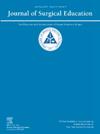训练腹腔镜外科医生:使用Nasa-Tlx评估工作量和技能
IF 2.1
3区 医学
Q1 EDUCATION, SCIENTIFIC DISCIPLINES
引用次数: 0
摘要
目的腹腔镜缝合是微创外科中技术要求最高的技能之一,需要细致的精神运动协调、精细的空间感知和精确的器械操作。尽管越来越强调基于模拟的训练,但很少有研究调查与腹腔镜缝合相关的主观工作量及其与客观绩效指标的相关性。本前瞻性研究旨在通过招募68名普外科住院医师参与标准化的基于盒子训练器的缝合任务来探索这些动态。使用NASA任务负荷指数(NASA- tlx)对参与者的主观工作量进行量化,该指数测量心理需求、身体需求、时间需求、感知表现、努力和挫折。目的采用新开发的缝合点系统评估缝合熟练程度,捕获缝线放置精度,张力控制和速度等参数。本研究在位于土耳其安卡拉的三级保健学术医疗中心Etlik市医院普外科诊所进行。该研究在该机构的外科培训计划中进行,利用为住院医师教育设计的标准化腹腔镜模拟实验室。结果:与高年级实习生相比,早期实习生(PGY-1和PGY-2)表现出更高的总体工作量得分和更低的缝合熟练程度。具体来说,PGY-1住院患者报告的NASA-TLX平均得分最高(72.38),主要是由于精神需求和努力的增加,在正确的缝合位置和时间方面表现最差。相比之下,PGY-5住院医师表现出明显较低的工作量指数(23.33),加上较好的缝合质量,突出了认知紧张的稳步减少和住院医师水平的技术技能的逐步提高。分析腹腔镜下的病例量进一步证实了这些发现:经验超过既定病例阈值的住院医生一致获得更高的复合缝合评分,并报告精神和身体需求减少。值得注意的是,基于性别的比较没有产生统计学上的显著差异,这表明在决定腹腔镜熟练程度和工作量感知方面,累积病例暴露和训练强度比性别更有影响。结论:这些观察结果强调了在结构化的、以能力为基础的课程中早期和有针对性地暴露于腹腔镜缝合任务的重要性。基于模拟的方法,特别是那些采用标准化反馈和人体工程学仪器设计的方法,可以加速技能的获得,减轻新手水平的疲劳或沮丧。从教育的角度来看,整合实时工作量评估工具,如NASA-TLX,可以帮助识别可能受益于量身定制干预措施的受训者,从而提高培训效率和患者安全。总之,本研究提供了强有力的证据,表明主观工作量和客观绩效指标都随着外科实习生在住院治疗中的进步和手术经验的积累而显著改善。这些发现支持一种外科教育模式,强调在模拟器设置中分阶段重复练习,最终目的是培养外科医生在最小的认知和身体压力下精通复杂的腹腔镜技术。本文章由计算机程序翻译,如有差异,请以英文原文为准。
Training Laparoscopic Surgeons: Assessing Workload and Skill Using Nasa-Tlx
Objective
Laparoscopic suturing stands as one of the most technically demanding competencies in minimally invasive surgery, requiring nuanced psychomotor coordination, refined spatial perception, and precise instrument handling. Despite the growing emphasis on simulation-based training, few studies have investigated the subjective workload associated with laparoscopic suturing and its correlation with objective performance metrics.
Design
This prospective study aimed to explore these dynamics by enrolling 68 general surgery residents in a standardized box-trainer-based suturing task. Participants’ subjective workload was quantified using the NASA Task Load Index (NASA-TLX), which measures mental demand, physical demand, temporal demand, perceived performance, effort, and frustration. Objective suturing proficiency was evaluated using a newly developed Suture Point System, capturing parameters such as suture placement accuracy, tension control, and speed.
Setting
This study was conducted at Etlik City Hospital, General Surgery Clinic, a tertiary care academic medical center located in Ankara/Turkey. The study took place within the institution’s surgical training program, utilizing a standardized laparoscopic simulation laboratory designed for resident education.
Results
The results revealed a pronounced learning curve: early-stage trainees (PGY-1 and PGY-2) exhibited higher overall workload scores and lower suturing proficiency compared to their senior counterparts. Specifically, PGY-1 residents reported the highest mean NASA-TLX scores (72.38), driven primarily by elevated mental demand and effort, and had the poorest performance in terms of correct suture placement and timing. By contrast, PGY-5 residents demonstrated significantly lower workload indices (23.33) coupled with superior suture quality, highlighting a steady reduction in cognitive strain and a progressive elevation of technical skills across residency levels. Analysis of laparoscopic case volume further corroborated these findings: residents with experience beyond established case thresholds consistently achieved higher composite suture scores and reported diminished mental and physical demands. Notably, sex-based comparisons did not yield statistically significant differences, suggesting that cumulative case exposure and training intensity are more influential than sex in determining laparoscopic proficiency and workload perception.
Conclusion
These observations underscore the importance of early and targeted exposure to laparoscopic suturing tasks within a structured, competency-based curriculum. Simulation-based approaches, particularly those employing standardized feedback and ergonomic instrument design, may accelerate skill acquisition and mitigate novice-level fatigue or frustration. From an educational standpoint, integrating real-time workload assessment tools such as NASA-TLX can facilitate the identification of trainees who might benefit from tailored interventions, thereby enhancing training efficiency and patient safety. In conclusion, this study provides robust evidence that both subjective workload and objective performance metrics improve significantly as surgical trainees progress in residency and accumulate procedural experience. These findings endorse a model of surgical education that emphasizes staged, repetitive practice in simulator settings, ultimately aiming to produce surgeons proficient in complex laparoscopic techniques with minimal cognitive and physical strain.
求助全文
通过发布文献求助,成功后即可免费获取论文全文。
去求助
来源期刊

Journal of Surgical Education
EDUCATION, SCIENTIFIC DISCIPLINES-SURGERY
CiteScore
5.60
自引率
10.30%
发文量
261
审稿时长
48 days
期刊介绍:
The Journal of Surgical Education (JSE) is dedicated to advancing the field of surgical education through original research. The journal publishes research articles in all surgical disciplines on topics relative to the education of surgical students, residents, and fellows, as well as practicing surgeons. Our readers look to JSE for timely, innovative research findings from the international surgical education community. As the official journal of the Association of Program Directors in Surgery (APDS), JSE publishes the proceedings of the annual APDS meeting held during Surgery Education Week.
 求助内容:
求助内容: 应助结果提醒方式:
应助结果提醒方式:


